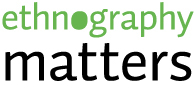May 2013: Persuasive Formats
I wanted to focus my own contribution to this month’s special edition (about “how to talk to companies about ethnography”) on presentation formats. That research findings will ultimately be delivered or presented is a given, but the particular format varies and seems often to be a matter of the conventions within particular organizational or research cultures. I’ve participated in ethnographic projects within the corporate sector. I’ve done a bit of consulting work for an NGO. The bulk of my career I’ve spent in Academia doing ethnographic work as most conventionally defined – culminating in the writing of an 80,000 word ethnographic monograph (which was text by-and-large with just a few black and white photos). On this basis, I’ve passed through a few different micro-worlds where different presentation practices prevailed.
In our interview with Steve Portigal this month I asked him about the hierarchy of formality he describes in his new book. For delivering the late-breaking or unprocessed findings (to communicate their informality) he uses e-mail, then Word documents, and finally polished results are delivered in PowerPoint. The ascendence of PowerPoint (not as an accompaniment to a project report, but as the report itself) in corporate settings and consultancy work I find really fascinating. Maybe because of the way it seems to prioritize communicating with as few words as possible, the pressure to edit down to the essentials, to consider what to omit just as much as what to include, how daunting! It seems obvious that this is reflection of the particularly intensive pressures of productivity, of delivering on the short project cycles of the private sector.
The Office suite of applications does not, by any means, encompass the full range of formats that are our options for communicating about ethnographic research. For example, my first job title when I worked in industry (at Intel Corp) was “Application Concept Developer.” My task was to translate research findings from our team of social scientists (who used interviews, observation, diary studies, copious photographs, etc) into interactive design concepts. These were not prototypes, but rather interactive demonstrations showing how insights from fieldwork fed into novel designs for computing systems. This was an attempt to communicate between social scientists and engineers…using the language of building and by engaging through interactivity.












Recent Comments